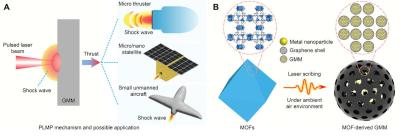Pulsed laser micropropulsion (PLMP) offers a promising avenue for miniature spacecraft, yet conventional propellants face challenges in balancing efficiency and stability. Researchers from Wuhan University, Henan Academy of Sciences and Purdue University have proposed an optical-propulsion metastructure strategy using metal-organic frameworks (MOFs) to generate graphene-metal metastructures (GMM), which significantly enhances PLMP performance.
A) Illustration of PLMP mechanism and the possible applications of MOFs-derived GMM-based PLMP. B) Preparation schematic of GMM. Image from: Advanced Materials
MOFs, which consist of metal cations or clusters coordinated with organic ligands, can serve as ideal precursors for creating hybrid structures that combine the benefits of both carbon and metal components. By employing ultrafast laser interactions with MOFs, researchers have been able to synthesize GMMs with precisely controlled metal nanoparticle sizes, graphene layers, and inter-particle gaps, all in an ambient air environment. These GMMs exhibit remarkable properties, including high light absorption efficiency, enhanced energy transfer, and improved material stability.
In GMMs, graphene acts as an efficient carrier for metal nanoparticles, facilitating strong light-matter interactions through localized plasmon resonance (LPR). This interaction significantly enhances the absorption and conversion of laser energy, which is critical for improving the performance of PLMP systems. The precise control over the size and distribution of metal nanoparticles within the graphene matrix also prevents aggregation and improves electron transfer efficiency, further boosting the overall effectiveness of the propellant.
Experimental and numerical analyses reveal that GMM-(HKUST-1) achieves aspecific impulse of 1072.94 s, ablation efficiency of 51.22%, and impulse thrust per mass of 105.15 µN µg−1, surpassing traditional propellants.
With an average particle size of ≈12 nm and a density of 0.958 g cm−3, these metastructures exhibit 99% light absorption efficiency and maintain stability under atmospheric and humid conditions.
The graphene nanolayer efficiently absorbs and converts laser energy, while the metal nanostructures enhance light-matter interactions, promoting energy transfer and material stability.
These findings suggest that this GMM-based optical-propulsion strategy can advance microspacecraft propulsion and energy systems, offering significant advancements across various domains.
